From Su-35 to Su-35. Different projects with similar names
First Su-Xnumx ...
The roots of the project called Su-35 should be sought in the late seventies. Soon after the completion of the main work on the Su-27 in its first production version of the OKB Design Bureau. BY. Sukhoi began to search for ways of modernization. Until a certain time, specialists were loaded with other work, and therefore the modernization project remained at the preliminary stages for a long time. However, the main ways of improving the existing machine were identified. First of all, it was proposed to upgrade the airborne equipment and weapons.
December 29 The new decree of the USSR Council of Ministers was issued on December 1983, according to which the OKB, headed by MP Simonov was supposed to develop a new project to upgrade the existing Su-27. The military and political leadership of the country saw the success of foreign aircraft manufacturers, and therefore required to improve the domestic technology. In accordance with the new task, the updated Su-27 was supposed to keep the circle of tasks to be solved, but it was necessary to increase its overall efficiency.
Initially, the Su-27 retrofit project received the most obvious and expected name, Su-27М. Despite a slight change in the original designation, the project envisaged the use of a number of completely new ideas and solutions that could have the most serious impact on the characteristics and capabilities of the fighter.
In 1985, the design team completed work on a draft version of the Su-27M project. Based on the existing requirements, aircraft manufacturers have made major changes in the existing glider and in its equipment. The most notable innovation of the project was the full-turning front horizontal tail, located in front of the wing. Also, the new aircraft was notable for a larger diameter fuselage nose, equipped with a removable fairing. Vizir optical-location station, previously located in front of the lamp on the longitudinal axis of the aircraft, shifted to the right. Increased brake flap. The tail rail of the fuselage was extended for the installation of new equipment. On the airframe there were new hatches for access to the internal compartments, a non-removable fuel receiver, a reinforced chassis, etc.
It was proposed to build a glider of the new design using new materials. A number of units are now planned to be made from aluminum-lithium alloys. In addition, the Su-27M project provided for a slight increase in the proportion of parts made of composite materials.
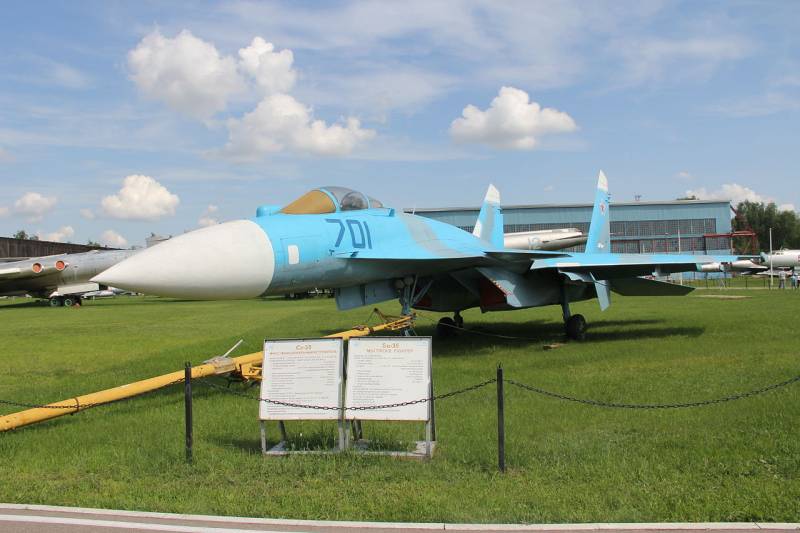
Su-27М / Т-10М-1 prototype aircraft in the Central Museum of the Air Force, Monino. Photo of Wikimedia Commons
Refinement of the nose of the fuselage was associated with the need to install a promising radar with a phased antenna array, which was distinguished by large dimensions. The selected station could find up to 24 targets at the same time and accompany the 8 of them. In the tail fairing it was planned to install a small-sized rear-view radar, which would increase the situational awareness of the crew.
An additional means of detection was the optical-location station with a thermal imager and a laser rangefinder-target designator. All data from the means of detection and tracking had to be transferred to the central computer and used in the preparation of the attack.
The Su-27M navigation system, in general, retained the appearance of the systems of the previous technology. It was proposed to use radio navigation devices, inertial course system and satellite signal receiver.
An interesting innovation of the project was a full-fledged airborne defense complex. In its composition were present means of electronic reconnaissance and optical sensors for launching rockets. It was proposed to counteract the incoming rockets with the help of a new station for jamming and for shooting off false thermal targets. Protection of the aircraft was to be carried out automatically, for which all elements of the complex were connected to a special computer.
For the first time in domestic practice, it was proposed to build cab equipment using multifunctional liquid crystal screens. Button-framed screens should have provided the pilot with all the necessary information. Standard electromechanical instruments and indicators now duplicate and only supplemented the screens. Also, for greater ease of piloting, a new wide-angle indicator on the windshield was developed. It was supposed to introduce a so-called. Helmet sighting system, simplifying the use of certain types weapons.
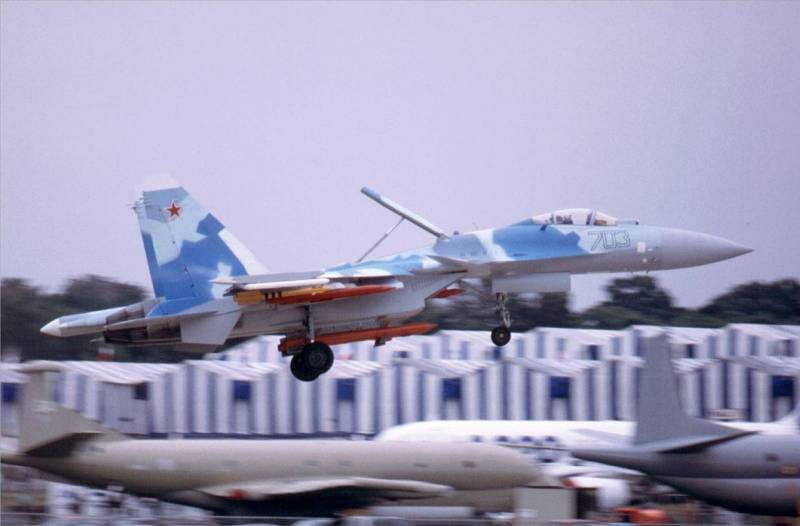
The prototype T-10M-2 performs a demonstration flight at the Farnborough-1994 air show. Photo of Wikimedia Commons
Due to some refinement of the airframe, it was possible to find a place for two additional points of the external suspension, as a result of which their number was brought to 12. Su-27M could carry the entire range of ammunition serial Su-27. In addition, it was possible to include perspective air-to-air missiles of the medium-range RVV-AE, recently submitted for flight tests, in its ammunition assembly.
In 1987, the pilot production of the Machine-Building Plant. BY. Sukhoi began assembling the first experienced Su-27M. The basis for this machine took a serial fighter. After a series of necessary improvements, the Su-27 received its own name T-10-1. Soon began the "construction" of the second experienced Su-27M. It should be noted that these machines did not fully comply with the new project. They lacked some promising devices, and in addition, they retained the standard chassis design.
28 June 1988 of the year at the Flight Research Institute. M.M. Gromov held the first flight of an experienced T-10M-1. The 19 of January of the following year was joined by the T-10M-2 fighter. For some time only two prototypes were used in testing, but soon the serialization of serial equipment continued. Almost all of the new Su-27M aircraft were rebuilt from serial fighter aircraft of the basic modification. For technical and technological reasons, the prototypes differed in one way or another.
Differences in the configuration were due to the need to work out various onboard systems. For example, the prototype T-10М-6, assembled in Moscow, became the first carrier of a reworked electric remote control system. The T-10М-4 product stood apart. This airframe did not receive any equipment, since it was intended for static tests.
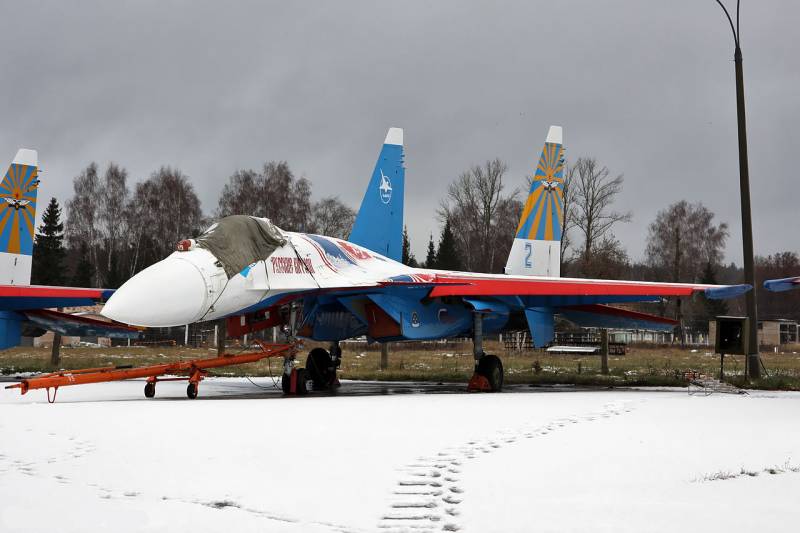
Su-27М / Su-35 / Т-10М-12 prototype after transfer to the Russian Knights group. Photo by Vitalykuzmin.net
April 1, 1992 the prototype T-10M-3 - the first of the built in Komsomolsk-on-Amur - took off. In the early nineties Komsomolsk-on-Amur aviation Production Association Yu.A. Gagarina began preparations for the future serial construction of new equipment, and for some time it was necessary to collect prototypes. Aircraft from KnAAPO had some differences from Moscow. So, to increase the flight range, they were equipped with more capacious fuel tanks. A pair of new fuel tanks was in keels of an increased area.
Production of prototype Su-27M continued until the 1995 year. From the pilot series, consisting of 12 aircraft, three machines (№1, №2 and №6) were assembled at the Moscow Machine-Building Plant, the rest - in Komsomolsk-on-Amur. Tests of all the techniques were carried out in Zhukovsky at the LII aerodrome.
... then Su-35
The Su-27M project provided for the most serious processing of the original design, and therefore in September 1992 of the year he was assigned a new factory designation - Su-35. The documents of the military department fighter still appeared as Su-27M. The customer and the developer assumed in the near future to start mass production of new technology, but this did not happen. The Sukhoi Design Bureau began to consider the new aircraft as a possible product for sale abroad, and it was supposed to promote it on the international market under the new name Su-35.
However, mass production was still launched, although it did not show outstanding results. In 1995, three Su-27М / Su-35 series were built. The following year, this equipment was sent to the State Flight Test Center, where it was studied by specialists of the armed forces. Operation of three aircraft in GLITs lasted for several years. In 2003, three production Su-27М, as well as experimental machines T-10-3 and T-10-12 were transferred to the Russian Knights aerobatic team.
By the mid-nineties, it became clear that, in its current form, the Su-35 did not fully meet the requirements of the foreseeable future. To save the desired combat potential, the fighter needed a new modernization. The glider and the power plant, in general, arranged for both the designers and the military, as a result of which the next update should have affected only electronics and weapons.
The new version of the project involved the use of a promising radar H011 "Bars" with a phased antenna array, which was distinguished by a more sophisticated computing unit. Due to the latter, it was possible to increase the number of targets to be tracked and followed. More powerful transmitting equipment has increased the station's range. Also, a new combat mode, combining work on air and ground targets.
New equipment installed on the T-10М-11 and Т-10М-12 aircraft, which became the latest representatives of the experimental series. The development of advanced equipment started in 1995-96 and lasted for several years. The results of these works were used to create new types of aircraft and equipment for it.
From the end of the eighties there was a development of a new engine based on the existing AL-31F. In addition to improving the main characteristics in a promising project, it was proposed to apply thrust vector control due to a nozzle of a variable configuration. The first aircraft with engines of AL-31FP was experienced Su-35 №11. His first flight took place on 2 on April 1996. At a certain point, obviously, for marketing reasons, the prototype vector-controlled aircraft was renamed Su-37.
In 2000, a prototype of a Su-35UB (T-10UBM) combat training aircraft first took to the air. In this project, the main developments in Su-35, Su-37 and Su-30MK fighters were combined. As a result, a promising double car appeared, capable of solving various tasks. She could provide training for aircrews, as well as perform combat tasks associated with attacking air or ground targets.
Back in the early nineties, there was a proposal to start mass production of Su-27M / Su-35 aircraft or their modified versions. Also from a certain time it was planned to supply such equipment for export. However, the financial problems of the Russian Ministry of Defense and certain difficulties of a production nature did not allow the implementation of these plans. The entire serial production of the Su-35 was limited to only three 1995-96 machines. Such equipment was not exported.
The lack of real prospects led to sad consequences. At the beginning of the two thousandth, it was decided to abandon the project Su-35. Part of the available technology was transferred to the museums and structures of the air force. Several prototypes were used as platforms for testing new equipment. Further development of the project has not yet been planned.
Another Su-35
In 2005, it was decided to resume the Su-35 project, and with real plans for serial production and supplies to the troops. For several reasons, it was intended to use not the original Su-27М / Su-35 project, but its modified version of the Su-35BM. This project actually provided for a deep modernization of the older Su-27 using onboard equipment developed for the Su-35 or based on its equipment.
The Su-35BM aircraft received a glider based on the original Su-27. It differed from the Su-35 by the absence of the front horizontal tail assembly on the brake flap. The radar with the H035 Irbis passive phased antenna array, supplemented with an optical-electronic station, became the basis of the aiming-navigation complex. Also significantly updated airborne electronic reconnaissance and electronic warfare. The cabin was equipped with three LCD screens and a holographic indicator on the windshield.
At the rear of the fuselage are two turbojet engines AL-41F1C. The most important feature of these products is a controlled nozzle, through which the full thrust vector control is implemented. Despite some reduction in thrust performance compared to the AL-41F1 engine, the products for Su-35BM showed sufficient performance and gave the aircraft all the necessary capabilities.
In 2007, the first prototype of the new model, T-10BM, was built. After several months of ground testing, this sample took to the air. The first flight took place on February 19 2008, under the control of test pilot Sergei Bogdan. The second prototype aircraft connected to flight tests in October of the same year. After several months, tests were carried out using three Su-35BM.
In August, 2009, during the MAKS aerospace show, the Ministry of Defense and the United Aircraft Building Corporation signed the first contract for the serial construction of new technology. The Su-35BM series was launched under the name Su-35С. Two years later, the state tests of two pre-production fighters began. All specifications were confirmed, which allowed to deploy full-scale mass production.
The 2009 contract of the year provided for the construction of the 48 new aircraft. All the cars in this series were handed over to the customer by the end of 2015. In December, 2015 appeared the second contract for 50 fighters with delivery up to 2020. It is not yet known whether new agreements on the construction of the Su-35C will be signed. Shortly before the second Russian contract, the first export agreement appeared. The first foreign buyer of the Su-35C was China, who wished to receive an 24 aircraft. In February, 2018, the 11 machines, was ordered by Indonesia.
To date, the aerospace forces of Russia have received 68 Su-35С aircraft from 98 ordered. The production of equipment is proceeding at a fairly high pace, and so far there is no reason to doubt the possibility of fulfilling the order within the specified time frame. Thus, at the beginning of the next decade, there will be almost a hundred of the newest 4 ++ generation fighters in the army.
From Su-35 to Su-35
The name of the Su-35 appeared a quarter of a century ago and was initially only used by the developer. Under this title was offered a promising machine of a rather courageous appearance, which could well have had a very serious impact on the combat potential of the air force. However, due to well-known reasons and characteristic problems of the time, the first Su-35 never went into the series, and at some point this project was even closed.
In the middle of the last decade, a fundamental decision was made to resume a closed project, but using new ideas and solutions. The real results of this were obtained in just a few years, and in 2009, the first contract for mass production appeared. Later, simultaneously with its completion, they signed another agreement.
A few days ago turned 10 years from the day of the first flight of an experienced Su-35BM / Su-35С. Over the past years, the aviation industry has solved a number of complex tasks and established a full-scale serial production of new technology. Each year, the armed forces receive several new Su-35Cs, and in the near future their number will approach one hundred. Despite all the difficulties and problems, the Su-35 project, even if in a significantly revised form, reached mass production and contributed to the defense capability.
Based on:
http://mil.ru/
http://ria.ru/
http://tass.ru/
http://sukhoi.org/
http://airwar.ru/
http://militaryrussia.ru/blog/topic-533.html
Ilyin V.E. Combat aircraft of Russia of the XXI century. - M .: Astrel / AST, 2000.
Belyaev V.V., Ilyin V.E. Russian modern aviation: an illustrated guide. - M .: Astrel / AST, 2001.
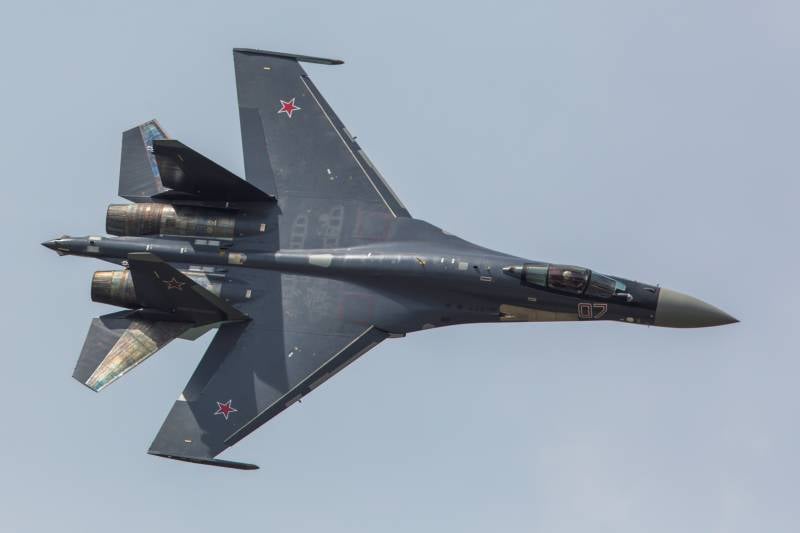
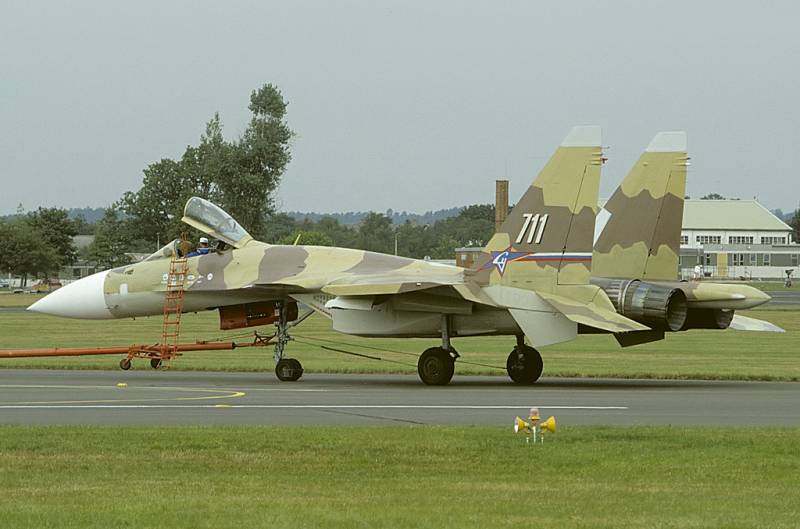
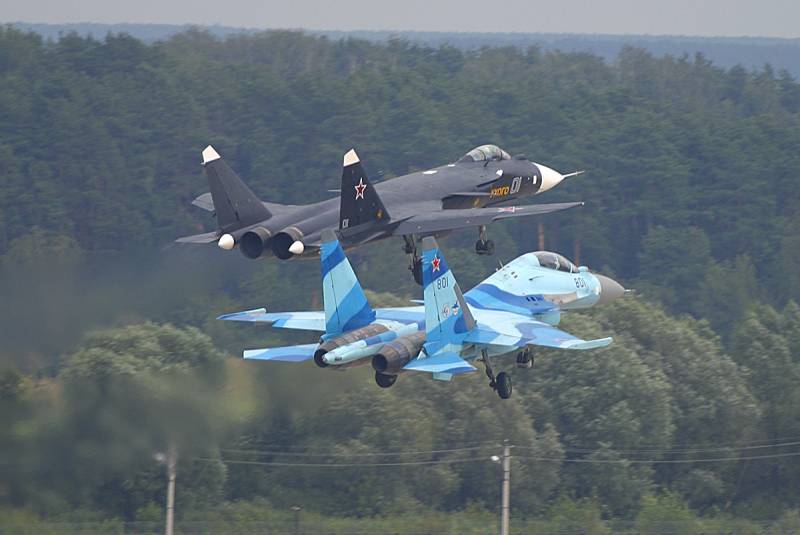
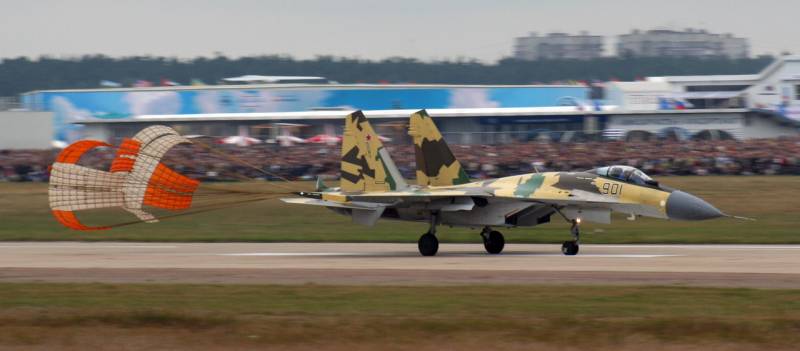
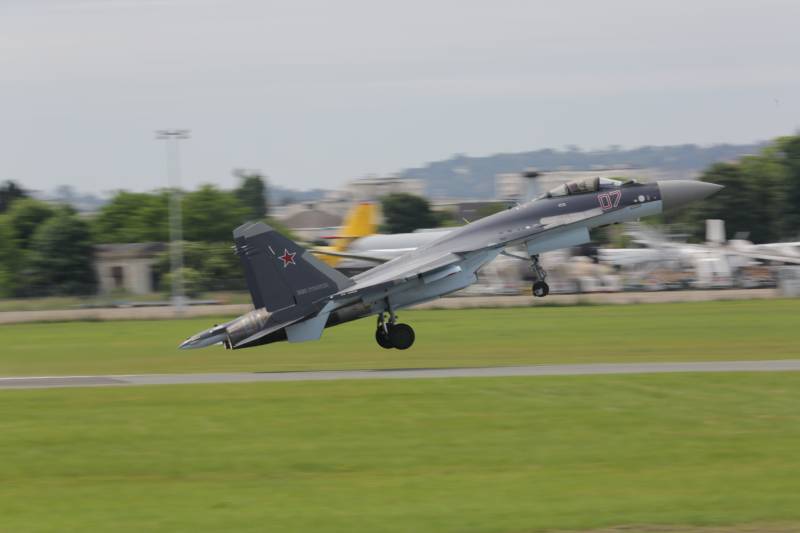
Information